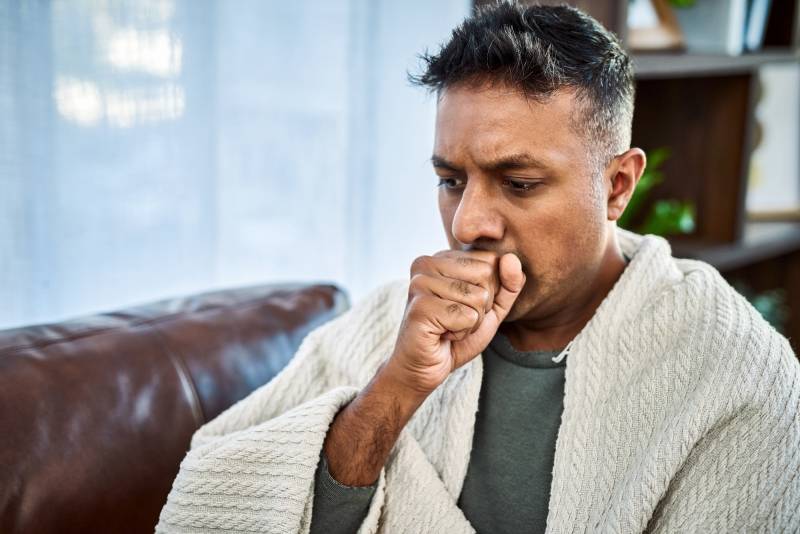In San Francisco, there have been 84 reported cases this year, a massive increase considering there was only one reported case in all of 2023.
“It’s entirely possible that a lot of the rise that we’re seeing not only in the Bay Area but also nationwide when it comes to whooping cough is related to a lower-than-ideal vaccination rate,” said Dr. Alok Patel, a pediatric hospitalist at Stanford Children’s Health.
Whooping cough, also known as pertussis, largely affects young children and infants, although adults and teens are also at risk of contracting the bacterial disease. The respiratory illness is incredibly contagious and can easily spread through exposure to droplets released during a cough or sneeze.
While symptoms of pertussis may resemble those of a common cold — mild cough, low fever and a runny nose — serious infections can result in respiratory pain, prolonged coughing fits and difficulty breathing. In severe cases, the infection can even be fatal for school-age children and babies who have not been vaccinated.
According to Patel, the ideal vaccination rate for herd immunity against whooping cough is 95%. He noted, however, that several counties in both the Bay Area and the rest of California have vaccination rates well below that number.
“If you have multiple groups of unvaccinated individuals, whether that is by choice or because a child is too young to get vaccinated, it’s easier for an infectious disease that’s really contagious, like whooping cough, to spread among multiple children,” Patel said.
For years, Marin County was known for vaccine hesitancy among its largely highly educated, affluent parents, many of whom were skeptical of traditional medicine and pharmaceutical companies. In the 2010s, it led the Bay Area in so-called personal belief exemptions to required immunizations for schoolchildren. During the pandemic, public health officials made strides in boosting COVID-19 vaccine rates there.
As whooping cough rates soar, Patel advised parents to make sure their children’s vaccinations are up to date as soon as possible.
In addition to lower vaccination rates, some experts suggest that there has been a loss of immunity over time even for those who have previously been vaccinated, leading to higher case infection rates.
Patel said the disease spreads most effectively in clusters due to its contagious nature. He noted that many pandemic-era practices may be useful when it comes to stopping the spread.
Consistent handwashing, basic hygiene and wearing a mask can help prevent further infections, Patel noted. He also added that individuals who suspect they may be sick should stay home and that public messaging needs to reflect the seriousness of this respiratory disease so that employers and teachers are more lenient when it comes to excusing absences.
Still, Patel emphasized that the most effective way to stop the spread of whooping cough is to get vaccinated.
“Before we had an effective whooping cough vaccine, in the 1940s, there were an estimated over 200,000 cases of whooping cough per year that we knew about,” Patel said. “If you fast forward a few decades, that number dropped by 99% in the mid-’70s. We have a completely effective vaccine that has proven its worth for 80 years.”
Do I need to get the whooping cough vaccine?
The “whooping cough vaccine” is actually a combination vaccine that protects against not just pertussis but also tetanus and diphtheria. It’s called the DTaP vaccine for babies and children under 7 and the Tdap vaccine for older children and adults.
For babies and young children (DTaP vaccine)
Multiple shots are recommended for maximum immunity. Babies are recommended to get three DTaP shots — one at 2 months, 4 months and 6 months.
The Centers for Disease Control and Prevention recommends that children then get two booster shots later (at 15–18 months and 4–6 years) to maintain their protection in early childhood.
For older children (Tdap vaccine)
The CDC said that preteens should get a Tdap shot between the ages of 11 and 12 years as a booster — and any teenager who didn’t get this earlier shot should get one the next time they visit their provider.
For adults (Tdap vaccine)
If you’re an adult who’s never had a Tdap shot, the CDC said you should get one — at any time. The agency also recommends that adults get a booster every 10 years. Pregnant people are also advised to get a Tdap shot early in their third trimester of every pregnancy to protect their baby from whooping cough in their vulnerable first few newborn months.
Where can I find a shot in the Bay Area?
If you have health insurance, the CDC’s recommendation of these shots means that your insurer should cover the costs. You can find appointments for a Tdap vaccine at:
For those without insurance: Uninsured children ages 18 and under can get free DTaP vaccines — and other no-cost immunizations — as part of the Vaccines for Children Program. People without insurance can get the vaccine at a lower cost — or even free if they qualify for the Vaccines for Adults Program — from several providers and community clinics around the Bay Area, including:
(And while you’re at it, remember that now is a great time to get your updated COVID shot and your flu vaccine, too, as we enter winter respiratory virus season.)

